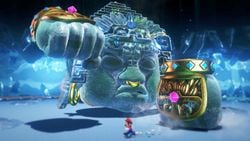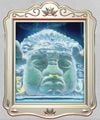Knucklotec: Difference between revisions
m (Removed protection from "Knucklotec") |
Tag: Undo |
||
| Line 11: | Line 11: | ||
He is encountered when Mario enters the sand flow directly beneath the Inverted Pyramid. When he appears, he is distraught over the loss of the kingdom's [[Binding Band]], and presumes Mario to have stolen it. Along with Bowser's icy water attack, he is the cause of the ice in the [[Sand Kingdom]], and when he is defeated all the ice melts away. Defeating him also creates a smaller sand flow where his head stuck out on the desert surface, leading straight down into the arena where he was fought which then becomes inhabited with [[Chincho]]s and a lone [[Coin Coffer]]. | He is encountered when Mario enters the sand flow directly beneath the Inverted Pyramid. When he appears, he is distraught over the loss of the kingdom's [[Binding Band]], and presumes Mario to have stolen it. Along with Bowser's icy water attack, he is the cause of the ice in the [[Sand Kingdom]], and when he is defeated all the ice melts away. Defeating him also creates a smaller sand flow where his head stuck out on the desert surface, leading straight down into the arena where he was fought which then becomes inhabited with [[Chincho]]s and a lone [[Coin Coffer]]. | ||
In battle, Knucklotec slams his fists into the ground; if one of his fists hits a sheet of ice on the ground, he briefly writhes in pain. Mario must then [[capture]] one of the fists and use it to knock out Knucklotec while avoiding the ice shards he fires from his other fist. After being hit once, he will slide his fists across the battlefield one time; the fists travel parallel to each other. He will then slam his hands on the ground, causing icicles to fall down and bury halfway onto the ground. Mario must then repeat the process once more. During the third phase, his fist-slide attack is slightly faster, and he has an additional attack where his hands lock onto Mario before clapping together multiple times. After being defeated, Knucklotec will explode, releasing the Sand Kingdom's second Multi Moon. | In battle, Knucklotec slams his fists into the ground; if one of his fists hits a sheet of ice on the ground, he briefly writhes in pain. Mario must then [[capture]] one of the fists and use it to knock out Knucklotec while avoiding the ice shards he fires from his other fist. After being hit once, he will slide his fists across the battlefield one time; the fists travel parallel to each other. He will then slam his hands on the ground, causing icicles to fall down and bury halfway onto the ground. Mario must then repeat the process once more. During the third phase, his fist-slide attack is slightly faster, and he has an additional attack where his hands lock onto Mario before clapping together multiple times. After being defeated, Knucklotec will explode, releasing the Sand Kingdom's second Multi Moon. According to the Japanese guide book ''Super Mario Odyssey: The Complete Guide'', after the fight, the citizens of the Sand Kingdom worked to repair Knucklotec.<ref>「アッチーニャ神との戦いの後、アッチーニャ神は住民によって修復されています。」 ''("After the fight with Knucklotec, he has been repaired by the citizens.")'' — ''Super Mario Odyssey: The Complete Guide'', page 199.</ref> | ||
In the rematch against him in [[Peach's Castle]], Knucklotec's attacks create hordes of Chinchos; at the start of the battle and after he does his fist-sliding attack, fist-smashing attack or his fist-clapping attack. Hordes of Chinchos also appear when the ice crystals fall after a hit is scored on the boss. | In the rematch against him in [[Peach's Castle]], Knucklotec's attacks create hordes of Chinchos; at the start of the battle and after he does his fist-sliding attack, fist-smashing attack or his fist-clapping attack. Hordes of Chinchos also appear when the ice crystals fall after a hit is scored on the boss. | ||
| Line 50: | Line 50: | ||
==Trivia== | ==Trivia== | ||
*When fighting Knucklotec subsequent times in the [[Mushroom Kingdom (Super Mario Odyssey)|Mushroom Kingdom]], the Multi Moon will appear to be uncollected when it's first revealed before showing to be a collected Multi Moon. This does not happen with any other boss in the game. | *When fighting Knucklotec subsequent times in the [[Mushroom Kingdom (Super Mario Odyssey)|Mushroom Kingdom]], the Multi Moon will appear to be uncollected when it's first revealed before showing to be a collected Multi Moon. This does not happen with any other boss in the game. | ||
==References== | |||
<references/> | |||
{{SMO}} | {{SMO}} | ||
Revision as of 08:00, August 23, 2019
- “Where...ring...go? YOU take ring?!”
- —Knucklotec, Super Mario Odyssey
Knucklotec is the second boss of the Sand Kingdom in Super Mario Odyssey. He is based off of the real-world Olmec heads, and has several similarities to Eyerok from Super Mario 64, due to both being ancient stone guardians found underground in deserts, having giant floating hands, and speaking in broken grammar.
Knucklotec can be first found in the desert, with the top part of his head sticking out from the ground and his Multi Moon plainly visible. Mario can walk on top of him in this state and Ground Pound him, where he will twitch and sometimes make a growling sound.
He is encountered when Mario enters the sand flow directly beneath the Inverted Pyramid. When he appears, he is distraught over the loss of the kingdom's Binding Band, and presumes Mario to have stolen it. Along with Bowser's icy water attack, he is the cause of the ice in the Sand Kingdom, and when he is defeated all the ice melts away. Defeating him also creates a smaller sand flow where his head stuck out on the desert surface, leading straight down into the arena where he was fought which then becomes inhabited with Chinchos and a lone Coin Coffer.
In battle, Knucklotec slams his fists into the ground; if one of his fists hits a sheet of ice on the ground, he briefly writhes in pain. Mario must then capture one of the fists and use it to knock out Knucklotec while avoiding the ice shards he fires from his other fist. After being hit once, he will slide his fists across the battlefield one time; the fists travel parallel to each other. He will then slam his hands on the ground, causing icicles to fall down and bury halfway onto the ground. Mario must then repeat the process once more. During the third phase, his fist-slide attack is slightly faster, and he has an additional attack where his hands lock onto Mario before clapping together multiple times. After being defeated, Knucklotec will explode, releasing the Sand Kingdom's second Multi Moon. According to the Japanese guide book Super Mario Odyssey: The Complete Guide, after the fight, the citizens of the Sand Kingdom worked to repair Knucklotec.[1]
In the rematch against him in Peach's Castle, Knucklotec's attacks create hordes of Chinchos; at the start of the battle and after he does his fist-sliding attack, fist-smashing attack or his fist-clapping attack. Hordes of Chinchos also appear when the ice crystals fall after a hit is scored on the boss.
Gallery
Names in other languages
| Language | Name | Meaning | Notes |
|---|---|---|---|
| Japanese | アッチーニャ神[?] Acchīnya Kami |
Tostarena God | |
| Chinese | 阿炽尼亚神 (Simplified) 阿熾尼亞神 (Traditional)[?] Āchìníyǎ shén |
Tostarena God | |
| Dutch | Knucklotec[?] | - | |
| German | Faustezuma[?] | From Faust (fist) and Montezuma | |
| Italian | Sganassotec[?] | From sganassone, an Italian slang for a hand slap | |
| Korean | 아뜨레나신[?] Atteurenashin |
Tostarena God | |
| Russian | Кулакатль[?] Kulakatl' |
From кулак kulak (fist) and Quetzalcoatl | |
| Spanish | Katunda[?] | From tunda (beating or thrashing) |
Trivia
- When fighting Knucklotec subsequent times in the Mushroom Kingdom, the Multi Moon will appear to be uncollected when it's first revealed before showing to be a collected Multi Moon. This does not happen with any other boss in the game.
References
- ^ 「アッチーニャ神との戦いの後、アッチーニャ神は住民によって修復されています。」 ("After the fight with Knucklotec, he has been repaired by the citizens.") — Super Mario Odyssey: The Complete Guide, page 199.



